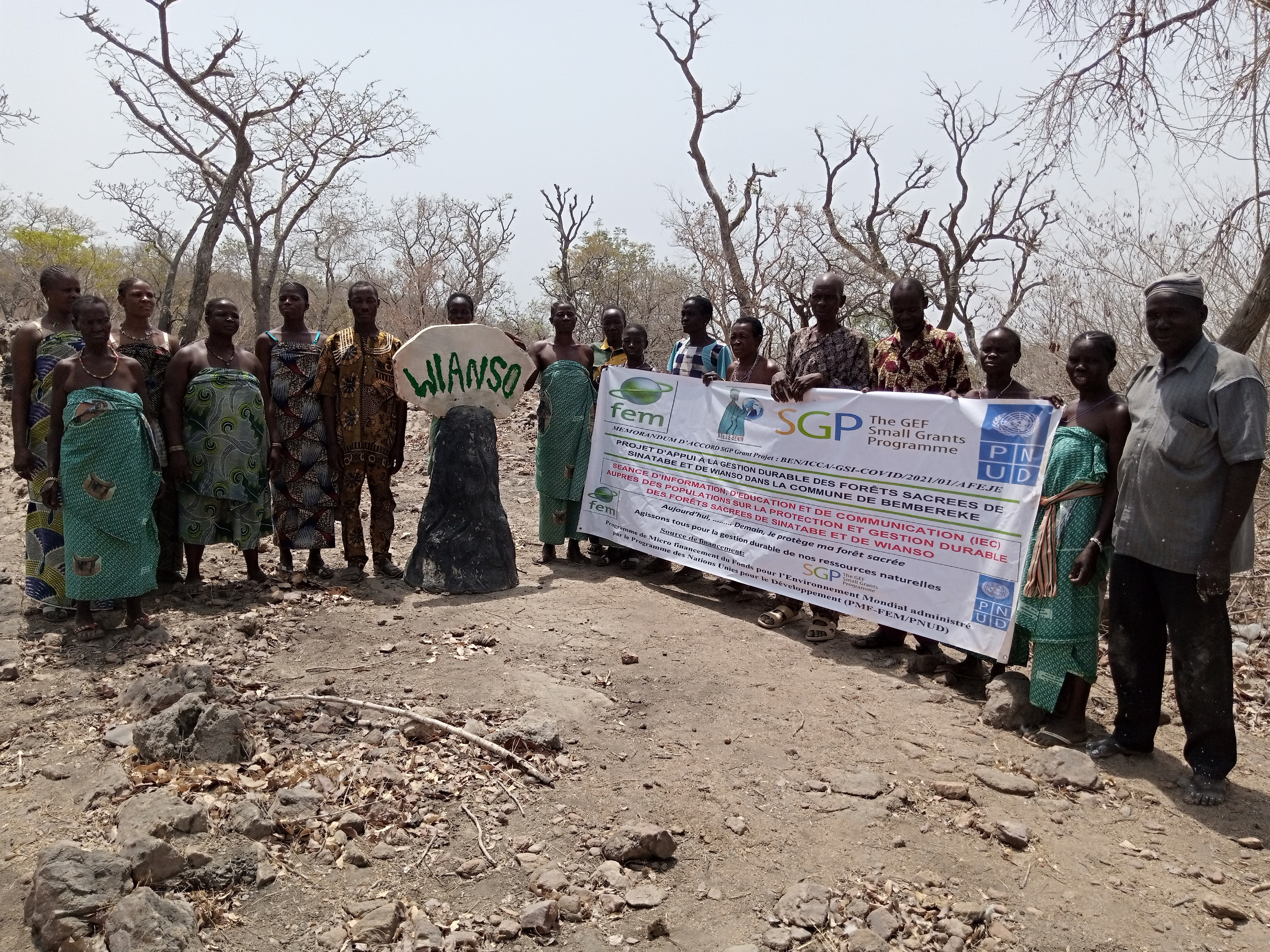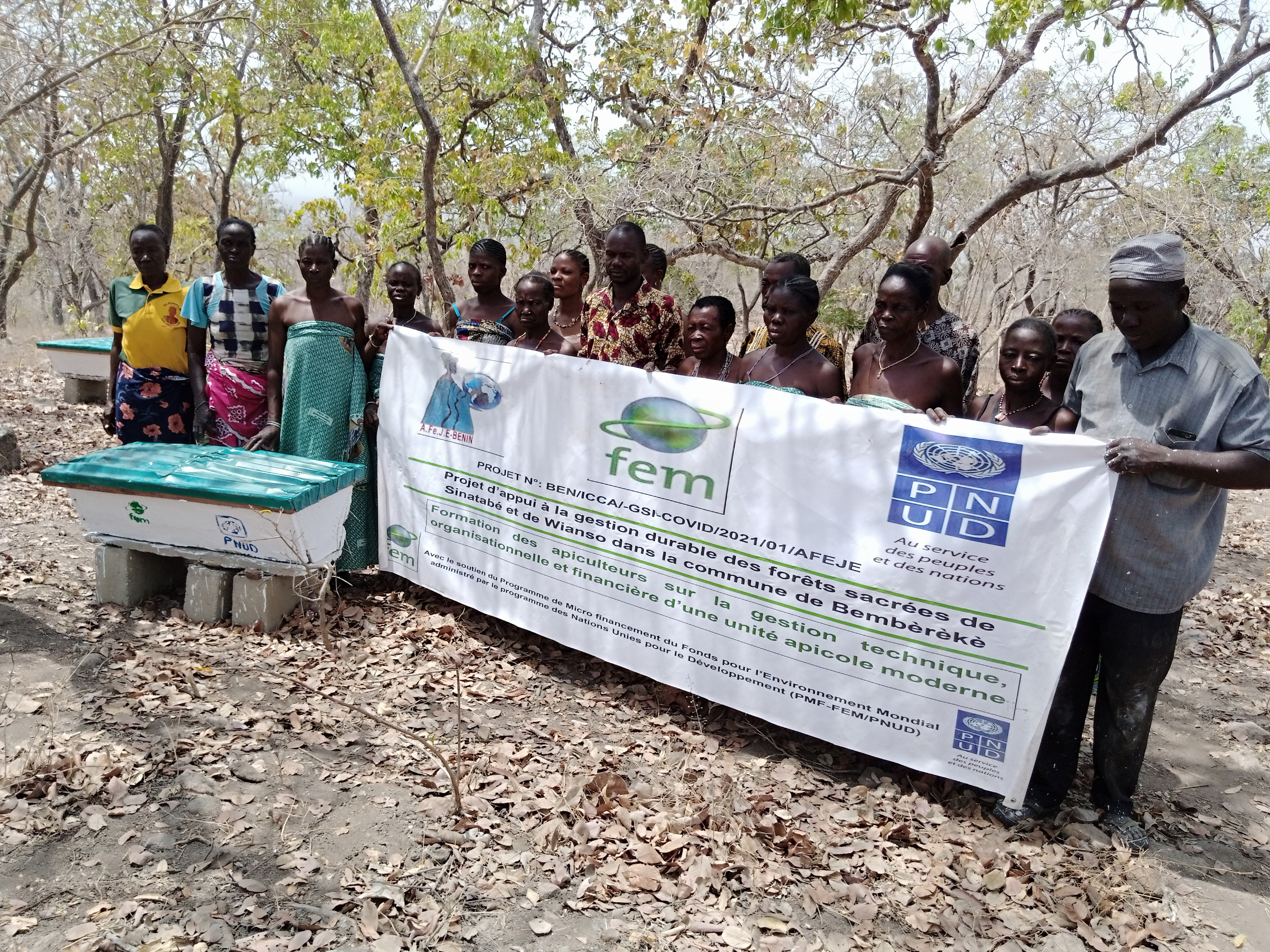Forêt sacrée de Wianso, Bénin
Introduction
The forest sacred of Wianso East located in Bembèrèkè - Ouest, district of Bembèrèkè in the commune of Bembèrèkè , in the department of Borgou , in Benin . The town of Bembèbèrèkè -Ouest has 2,509 inhabitants (INSAE, 2013), or 8% of the total population of the arrondissement of Bembèrèkè . In the municipality of Bembèrèkè there are two main groups socio-cultural : the Baatombu and relatives (48%) and the Peulh and relatives (38%). Forest managers _ _ sacred “the GANDE community ” belong to the socio- cultural groups Baatombu . Activities _ economic dominant in Bembèrèkè are agriculture (74%) and trade and catering (18%) (Monograph of the municipality of Bembèrèkè ). The dominant crops are maize, millet and yam. The forest Sacred Wianso is part of part of the forest classified of Ouénou-Bénou which delimits clearly his limits .
The forest sacred of Wianso represents a place of practice of the cult of " Wianso " venerated by the population of Bembèrèkè and the royal court . The variety of rites practiced in this forest sacred constitutes cultural richness _ exceptional and is fundamental for the identity of the Baatonou populations ( Baatonu is the language and Baatombu is the people) . It has always served as a source of blessing and protection, especially for royalty. The forest Sacred Wianso has preserved for several _ decades of rare and endangered plant and animal species and medicinal plants .
In terms of organization social , there is great respect for traditional institutions. The traditional chief has more authority in some places than the elected official. The decree interministerial decree n° 021/MEHU/MDGLAT/DC/SGM/DGFRN/SA of November 16, 2012, providing a framework for the community management of sacred forests in Benin, makes it possible to ensure local forest management.
History and activities
The forest sacred of Wianso exist for over a hundred years. It is one of the places where King BIO GUERA resisted colonization . Wianso has been propose as protected area before the 2000s, but its recognition at the local level was effective through the decree interministerial decree n°021/MEHU/MDGLAT/DC/SGM/DGFRN/SA of November 16 , 2012, providing a framework for community management of sacred forests in Benin. This gives it recognition through various structures, such as the Town Hall and the Inspection Forestière , which support the enrichment and conservation actions undertaken.
The forest church of Wianso owes its name to the divinity Wianso , of which the mind East housed in an Iroko tree in the heart of the sacred forest. Around this Iroko tree, there is a ribbon white which symbolizes the purity of the spirit . This deity helps ward off evil spells and bestows blessings such as victory, fertility, and abundance of goods in the life of the person asking . It was installed by the King of Bembèrèkè . Historically , the forest sacred of Wianso East therefore a heritage , left by the ancestors to the GANDE clan. Everyone is allowed access to the sacred place, regardless of gender or rank. However, it is forbidden to bring females, goats and guinea fowl into the forest. Any sacrifice of these animals is prohibited so as not to attract the wrath of the spirits. Within the lineage of GANDE, the priest of the divinity is chosen by the sages of the King (the traditional Chief). He is the King's confidant and deals with affairs outside the Kingdom. The Curator forest current _ sacred of Wianso is ISSIFOU GANDE INOUSSA.
Ecological services
Water : Tiro River flows from the mountains of divinity Wianso of the forest sacred of Wianso until east of the town of Bembèrèkè . This water is used for all purposes (domestic use, drinks, laundry, buildings, etc.) throughout the year and especially in the dry season.
Climate change: The trees present participate in the regulation of the climate, in the fight against climate change and soil erosion.
Medicinal plants: The medicinal plants available in the forest are used to cure several diseases in the community.
Biodiversity and Conservation
Forest conservation sacred of Wianso will help preserve plant and animal species as well as medicinal plants . The forest Sacred Wianso is part of part of the forest classified by Ouénou-Bénou and the species vegetable present in this forest are diverse. They are big trees such as: Milicia Excelsa , Azadirachta indica, Khaya senegalensis and Sarcocephalus latifolus . Diversity _ wildlife East dominated by the guinea fowl (Numida meleagri ) , hare (Lepus crawshayi ), mona monkey (Cercopithecus mona), squirrel ( Protoxerius stangeri ), giant rats ( Cricetomys gambianus ), yellow - winged bat ( Lavia frons) , patas ( Erytrocebus patas ) and bushbuck (Tragelaphus scriptus). It exists also monitor lizards (Varanus sp ), vipers ( Viperidae ) and cobras ( Naja ) . There are several gastropods, including snails (such as Achatina spp.) and slugs. In addition they have turtles _ giantess
It exists currently a project (UNDP) in courses to support sustainable forest management sacred to Sinatabé and Wianso in the commune of Bembèrèkè . This project is implemented by an NGO called AFEJE BENIN ONG with the support of the Small Grants Program of the Global Environment Facility administered by the United Nations Development Program (PMF-GEF/UNDP). The actions of AFEJE BENIN with the support of the PMF-GEF/UNDP have made it possible to:
- revitalize the local forest management committee sacred of Wianso and increase its influence,
- begin the process of enriching the sacred forest by introducing new species of trees to restore its vegetation cover,
- develop eco-responsible activities such as beekeeping and rabbit farming for the benefit of local populations populations.
The management committee supported the actions of AFEJE BENIN by planting seedlings along the limits of the forest to reinforce its limits.
Actions taken in the forest sacred of Wianso have summer recognized and supported by the town hall of Bembèrèkè and the Inspection Borgou forester . _
How are conservation impacts measured or monitored?
A management committee made up of seven members oversees and participates in forest conservation actions sacred of Wianso . The impacts of forest conservation sacred of Wianso are measured in terms of restoration of plant cover, number of people supported by eco-responsible activities such as beekeeping instead of unsustainable activities and monitoring of changes by limiting human pressure in the forest. The ACPA community and the management committee are informed and involved before any action for the conservation or sustainable management of the sacred forest. Its action is limited to the level of the sacred forest and no interference is possible. The keeper of the forest sacred of Wianso participates in the activities of the national ICCA consortium. This consortium organizes the protection of local communities in ICCAs.
The direct beneficiaries of the projects are 15 beekeepers and five women who work in cuniculture (rabbit breeding) and the seven members of the management committee and the indirect beneficiaries, including the entire population of the municipality of Bembèrèkè for whom the forest sacred of Wiianso offers all its potential and advantages, especially once the developments have been completed. The animal and plant species present in the sacred forest will also be positively affected.
The commune of Bembèrèkè represents a huge asset for the local population. The geophysical and demographic circumstances allow the development of activities in the primary and secondary sectors, socio-economic and community infrastructures, as well as opportunities related to the realization of any development project. It also offers a range of sacred and tourist sites for tourism development.
Threats to the region
The forest sacred of Wianso was under strong anthropogenic pressure marked by exploitation uncontrolled wood , bush fires _ _ due to the influence scaled down monitoring committee of the Sacred Forest , and the lack of awareness among local populations.
Next steps
Future activities planned at forest level _ sacred of Wianso are
- mobilize others partners for development work,
- develop organic market gardening along the banks of the Tiro for the benefit of local women,
- continue the practice of beekeeping in the forest by introducing Kenyan hives,
- improve forest security _ _ of Wianso in an area of 10ha by providing modern tools to the forest protection committee.
Lessons learned
ICCAs remain important places for our communities. However, they are not immune to human pressures which can accelerate their degradation. Community awareness remains a prerequisite for the protection of ICCAs. In addition to this awareness, it is important to define activities that can ensure the sustainable management of these ICCAs.
This case study was originally published by UNEP-WCMC in March 2023. The content was provided by the custodians of this ICCA. The ICCA has been self-declared and has been through a peer-review process to verify its status. More details on this process can be found here. The contents of this website do not necessarily reflect the views or policies of UN Environment Programme or WCMC.

